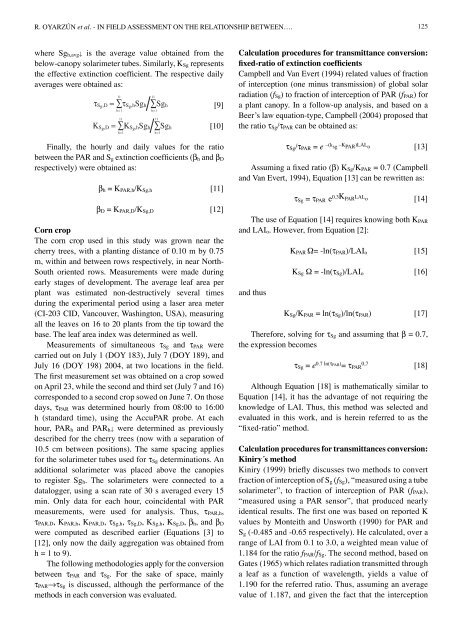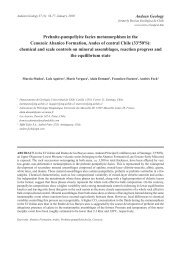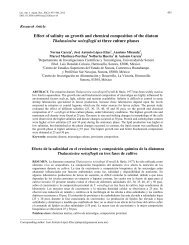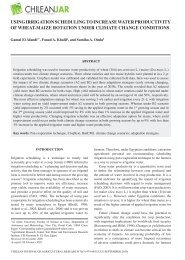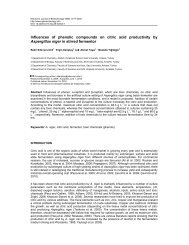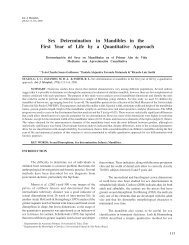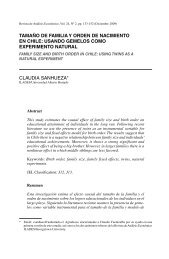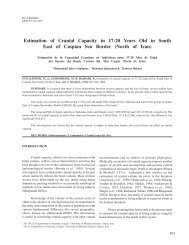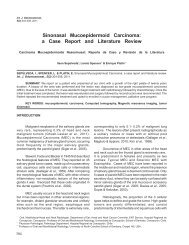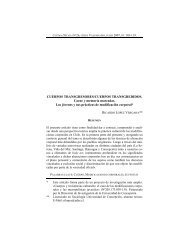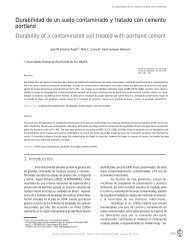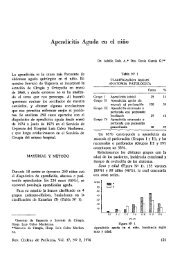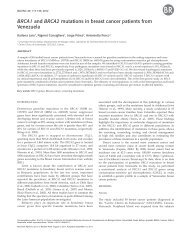(par) and global solar radiation transmittance t
(par) and global solar radiation transmittance t
(par) and global solar radiation transmittance t
Create successful ePaper yourself
Turn your PDF publications into a flip-book with our unique Google optimized e-Paper software.
R. OYARZÚN et al. - IN FIELD ASSESSMENT ON THE RELATIONSHIP BETWEEN….<br />
125<br />
where Sg h,avg↓ is the average value obtained from the<br />
below-canopy <strong>solar</strong>imeter tubes. Similarly, K Sg represents<br />
the effective extinction coefficient. The respective daily<br />
averages were obtained as:<br />
11<br />
τ Sg,D = ∑τ Sg,hSg h ∑Sg h<br />
h=1<br />
11<br />
[9]<br />
[10]<br />
Finally, the hourly <strong>and</strong> daily values for the ratio<br />
between the PAR <strong>and</strong> S g extinction coefficients (β h <strong>and</strong> β D<br />
respectively) were obtained as:<br />
β h = K PAR,h/K Sg,h [11]<br />
β D = K PAR,D/K Sg,D [12]<br />
Corn crop<br />
The corn crop used in this study was grown near the<br />
cherry trees, with a planting distance of 0.10 m by 0.75<br />
m, within <strong>and</strong> between rows respectively, in near North-<br />
South oriented rows. Measurements were made during<br />
early stages of development. The average leaf area per<br />
plant was estimated non-destructively several times<br />
during the experimental period using a laser area meter<br />
(CI-203 CID, Vancouver, Washington, USA), measuring<br />
all the leaves on 16 to 20 plants from the tip toward the<br />
base. The leaf area index was determined as well.<br />
Measurements of simultaneous τ Sg <strong>and</strong> τ PAR were<br />
carried out on July 1 (DOY 183), July 7 (DOY 189), <strong>and</strong><br />
July 16 (DOY 198) 2004, at two locations in the field.<br />
The first measurement set was obtained on a crop sowed<br />
on April 23, while the second <strong>and</strong> third set (July 7 <strong>and</strong> 16)<br />
corresponded to a second crop sowed on June 7. On those<br />
days, τ PAR was determined hourly from 08:00 to 16:00<br />
h (st<strong>and</strong>ard time), using the AccuPAR probe. At each<br />
hour, PAR h <strong>and</strong> PAR h↓ were determined as previously<br />
described for the cherry trees (now with a se<strong>par</strong>ation of<br />
10.5 cm between positions). The same spacing applies<br />
for the <strong>solar</strong>imeter tubes used for τ Sg determinations. An<br />
additional <strong>solar</strong>imeter was placed above the canopies<br />
to register Sg h. The <strong>solar</strong>imeters were connected to a<br />
datalogger, using a scan rate of 30 s averaged every 15<br />
min. Only data for each hour, coincidental with PAR<br />
measurements, were used for analysis. Thus, τ PAR,h,<br />
τ PAR,D, K PAR,h, K PAR,D, τ Sg,h, τ Sg,D, K Sg,h, K Sg,D, β h, <strong>and</strong> β D<br />
were computed as described earlier (Equations [3] to<br />
[12], only now the daily aggregation was obtained from<br />
h = 1 to 9).<br />
The following methodologies apply for the conversion<br />
between τ PAR <strong>and</strong> τ Sg. For the sake of space, mainly<br />
τ PAR→τ Sg is discussed, although the performance of the<br />
methods in each conversion was evaluated.<br />
11<br />
h=1<br />
K Sg,D = ∑K Sg,hSg h ∑Sg h<br />
h=1<br />
11<br />
h=1<br />
Calculation procedures for <strong>transmittance</strong> conversion:<br />
fixed-ratio of extinction coefficients<br />
Campbell <strong>and</strong> Van Evert (1994) related values of fraction<br />
of interception (one minus transmission) of <strong>global</strong> <strong>solar</strong><br />
<strong>radiation</strong> (f Sg) to fraction of interception of PAR (f PAR) for<br />
a plant canopy. In a follow-up analysis, <strong>and</strong> based on a<br />
Beer’s law equation-type, Campbell (2004) proposed that<br />
the ratio τ Sg/τ PAR can be obtained as:<br />
τ Sg/τ PAR = e –(k sg –K PAR )LAL o [13]<br />
Assuming a fixed ratio (β) K Sg/K PAR = 0.7 (Campbell<br />
<strong>and</strong> Van Evert, 1994), Equation [13] can be rewritten as:<br />
τ Sg = τ PAR e 0.3K PAR LAL o [14]<br />
The use of Equation [14] requires knowing both K PAR<br />
<strong>and</strong> LAI o. However, from Equation [2]:<br />
<strong>and</strong> thus<br />
K PAR Ω= -ln(τ PAR)/LAI o [15]<br />
K Sg Ω = -ln(τ Sg)/LAI o [16]<br />
K Sg/K PAR = ln(τ Sg)/ln(τ PAR) [17]<br />
Therefore, solving for τ Sg <strong>and</strong> assuming that β = 0.7,<br />
the expression becomes<br />
τ Sg = e 0.7 ln(τPAR) = τ PAR<br />
0,7<br />
[18]<br />
Although Equation [18] is mathematically similar to<br />
Equation [14], it has the advantage of not requiring the<br />
knowledge of LAI. Thus, this method was selected <strong>and</strong><br />
evaluated in this work, <strong>and</strong> is herein referred to as the<br />
“fixed-ratio” method.<br />
Calculation procedures for <strong>transmittance</strong>s conversion:<br />
Kiniry´s method<br />
Kiniry (1999) briefly discusses two methods to convert<br />
fraction of interception of S g (f Sg), “measured using a tube<br />
<strong>solar</strong>imeter”, to fraction of interception of PAR (f PAR),<br />
“measured using a PAR sensor”, that produced nearly<br />
identical results. The first one was based on reported K<br />
values by Monteith <strong>and</strong> Unsworth (1990) for PAR <strong>and</strong><br />
S g (-0.485 <strong>and</strong> -0.65 respectively). He calculated, over a<br />
range of LAI from 0.1 to 3.0, a weighted mean value of<br />
1.184 for the ratio f PAR/f Sg. The second method, based on<br />
Gates (1965) which relates <strong>radiation</strong> transmitted through<br />
a leaf as a function of wavelength, yields a value of<br />
1.190 for the referred ratio. Thus, assuming an average<br />
value of 1.187, <strong>and</strong> given the fact that the interception


